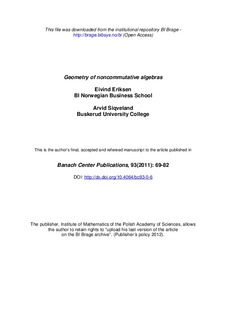| dc.description.abstract | There has been several attempts to generalize commutative algebraic geometry to the noncommutative situation. Localizations with good properties rarely exists for noncommutative algebras, and this makes a direct generalization di cult. Our point of view, following Laudal, is that the points of the noncommutative geometry should be represented as simple modules, and that noncommutative deformations should be used to obtain a suitable localization in the noncommutative situation.
Let A be an algebra over an algebraically closed eld k. If A is commutative and nitely generated over k, then any simple A-module has the form M = A=m, the residue eld, for a maximal ideal m A, and the commutative deformation functor DefM has formal moduli A^m. In the general case, we may replace the A-module A=m with the simple A-module M, and use the formal moduli of the commutative deformation functor DefM as a replacement for the complete local ring A^m. We recall the construction of the commutative scheme simp(A), with points in bijective correspondence with the simple A-modules of nite dimension over k, and with complete local ring at a point M isomorphic to the formal moduli of the corresponding simple module M. The scheme simp(A) has good properties, in particular when there are no in nitesimal relations between di erent points, i.e. when Ext1 A(M;M0) = 0 for all pairs of non-isomorphic simple A-modules M;M0. It does not , however, characterize A. We use noncommutative deformation theory to de ne localizations, in general, and we nd a presheaf O, of noncommutative algebras, de ned on the Jacobson topology of simp(A) which re nes the commutative scheme, simp(A), by accounting for the in nitesimal relations in simp(A). We consider the quantum plane, given by A = khx; yi=(xy qyx), as an example. This is an Artin-Schelter algebra of dimension two. | no_NO |
